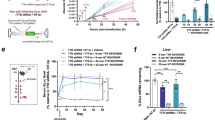Abstract
Adenoviruses are the most common vectors used in clinical trials of gene therapy. In 2017, 21.2% of clinical trials used rAds as vectors. Systemic administration of rAds results in high tropism in the liver. Interferon types α and β are the major antiviral cytokines which orchestrate the host’s immune response against rAd, limiting therapeutic gene expression and preventing subsequent vector administration. siRNA is small double-strand RNAs that temporally inhibit the expression of a specific gene. The aim is to evaluate the effect of IFN-α blocking by a specific siRNA on Ad-GFP transduction and on transgene expression in Huh7 cells in culture. Huh7 cells were cultured in DMEM and transfected with 70 nM of siRNA-IFN-α. Six hours later, the cells were exposed to 1 × 109 vp/ml of rAd-GFP for 24 h. Expression of IFN-α, TNF-α and the PKR gene was determined by RT-qPCR. Percentage of transduction was analyzed by flow cytometry and by qPCR. GFP expression was determined by western blot. 70 nM of siRNA-IFN-α inhibited 96% of IFN-α and 65% of TNF-α gene expression compared to an irrelevant siRNA. Percentage of transduction and transgene expression increased in these cells compared to an irrelevant siRNA. Inhibition of IFN-α expression by siRNA-IFN-α enabled a higher level of transduction and transgene expression GFP, highlighting the role of IFN-α in the elimination of adenovirus in transduced cells and thus suggesting that its inhibition could be an important strategy for gene therapy in clinical trials using adenovirus as a vector directed to liver diseases.





Similar content being viewed by others
References
Russell, W. C. (2009). Adenoviruses: Update on structure and function. Journal of General Virology, 90(Pt 1), 1–20.
Bangari, D. S., & Mittal, S. K. (2006). Current strategies and future directions for eluding adenoviral vector immunity. Current Gene Therapy, 6(2), 215–226.
Nociari, M., et al. (2007). Sensing infection by adenovirus: Toll-like receptor-independent viral DNA recognition signals activation of the interferon regulatory factor 3 master regulator. Journal of Virology, 81(8), 4145–4157.
Zhu, J., Huang, X., & Yang, Y. (2007). Innate immune response to adenoviral vectors is mediated by both Toll-like receptor-dependent and-independent pathways. Journal of Virology, 81(7), 3170–3180.
Cerullo, V., et al. (2007). Toll-like receptor 9 triggers an innate immune response to helper-dependent adenoviral vectors. Molecular Therapy, 15(2), 378–385.
Hartman, Z. C., et al. (2007). Adenovirus infection triggers a rapid, MyD88-regulated transcriptome response critical to acute-phase and adaptive immune responses in vivo. Journal of Virology, 81(4), 1796–1812.
Zhu, J., Huang, X., & Yang, Y. (2008). A critical role for type I IFN-dependent NK cell activation in innate immune elimination of adenoviral vectors in vivo. Molecular Therapy, 16(7), 1300–1307.
Decker, T., Muller, M., & Stockinger, S. (2005). The yin and yang of type I interferon activity in bacterial infection. Nature Reviews Immunology, 5(9), 675–687.
Katze, M. G., He, Y., & Gale, M., Jr. (2002). Viruses and interferon: A fight for supremacy. Nature Reviews Immunology, 2(9), 675–687.
Katze, M. G. (2002). Interferon, PKR, virology, and genomics: what is past and what is next in the new millennium? Journal of Interferon and Cytokine Research, 22(3), 283–286.
Thaci, B., et al. (2011). The challenge for gene therapy: innate immune response to adenoviruses. Oncotarget, 2(3), 113–121.
Armendariz-Borunda, J., et al. (2011). Production of first generation adenoviral vectors for preclinical protocols: Amplification, purification and functional titration. Journal of Bioscience and Bioengineering, 112(5), 415–421.
Chomczynski, P., & Sacchi, N. (2006). The single-step method of RNA isolation by acid guanidinium thiocyanate-phenol-chloroform extraction: twenty-something years on. Nature Protocols, 1(2), 581–585.
Livak, K. J., & Schmittgen, T. D. (2001). Analysis of relative gene expression data using real-time quantitative PCR and the 2(-Delta Delta C(T)) method. Methods, 25(4), 402–408.
Edelstein, M. L., Abedi, M. R., & Wixon, J. (2007). Gene therapy clinical trials worldwide to 2007—an update. Journal of Gene Medicine, 9(10), 833–842.
Koizumi, N., et al. (2007). Fiber-modified adenovirus vectors decrease liver toxicity through reduced IL-6 production. Journal of Immunology, 178(3), 1767–1773.
Mowa, M. B., Crowther, C., & Arbuthnot, P. (2010). Therapeutic potential of adenoviral vectors for delivery of expressed RNAi activators. Expert opinion on drug delivery, 7(12), 1373–1385.
Krasnykh, V. N., et al. (1996). Generation of recombinant adenovirus vectors with modified fibers for altering viral tropism. Journal of Virology, 70(10), 6839–6846.
Krasnykh, V., et al. (1998). Characterization of an adenovirus vector containing a heterologous peptide epitope in the HI loop of the fiber knob. Journal of Virology, 72(3), 1844–1852.
Chen, Q., et al. (2008). Therapeutic RNA silencing of Cys-X3-Cys chemokine ligand 1 gene prevents mice from adenovirus vector-induced acute liver injury. Hepatology, 47(2), 648–658.
Garcia-Banuelos, J., et al. (2002). Cirrhotic rat livers with extensive fibrosis can be safely transduced with clinical-grade adenoviral vectors. Evidence of cirrhosis reversion. Gene Therapy, 9(2), 127–134.
Siller-Lopez, F., et al. (2004). Treatment with human metalloproteinase-8 gene delivery ameliorates experimental rat liver cirrhosis. Gastroenterology, 126(4), 1122–1133. (discussion 949).
Salgado, S., et al. (2000). Liver cirrhosis is reverted by urokinase-type plasminogen activator gene therapy. Molecular Therapy, 2(6), 545–551.
Hiscott, J. (2007). Triggering the innate antiviral response through IRF-3 activation. Journal of Biological Chemistry, 282(21), 15325–15329.
Hiscott, J., et al. (1999). Triggering the interferon response: The role of IRF-3 transcription factor. Journal of Interferon and Cytokine Research, 19(1), 1–13.
Acknowledgements
This study was financially supported by CONACyT Grant 25474, awarded to Juan Armendariz Borunda.
Author information
Authors and Affiliations
Contributions
AAS-N performed all experimental phases. AS-R was assessor for the siRNA transfection experiment. JJG-B was assessor for the Adenovirus production. JA-B participated in writing the manuscript. AMS-M led the project and participated in writing the manuscript.
Corresponding author
Ethics declarations
Conflict of interest
Authors have nothing to disclose regarding conflicts of interest related to this manuscript.
Rights and permissions
About this article
Cite this article
Sobrevilla-Navarro, A.A., Sandoval-Rodríguez, A., García-Bañuelos, J.J. et al. Interferon-α Silencing by Small Interference RNA Increases Adenovirus Transduction and Transgene Expression in Huh7 Cells. Mol Biotechnol 60, 251–258 (2018). https://doi.org/10.1007/s12033-018-0066-7
Published:
Issue Date:
DOI: https://doi.org/10.1007/s12033-018-0066-7




